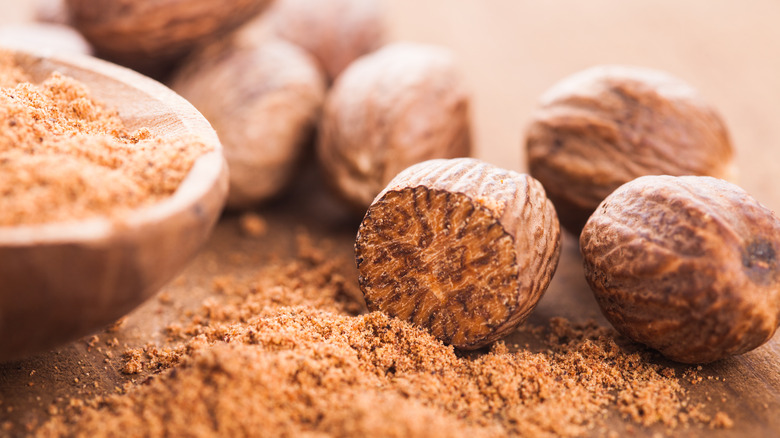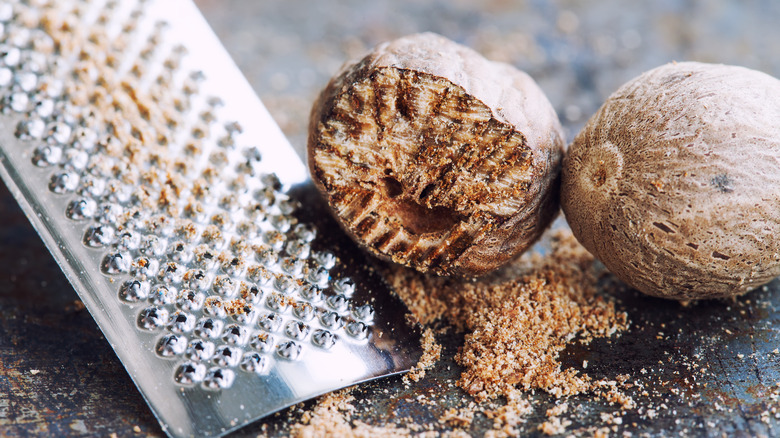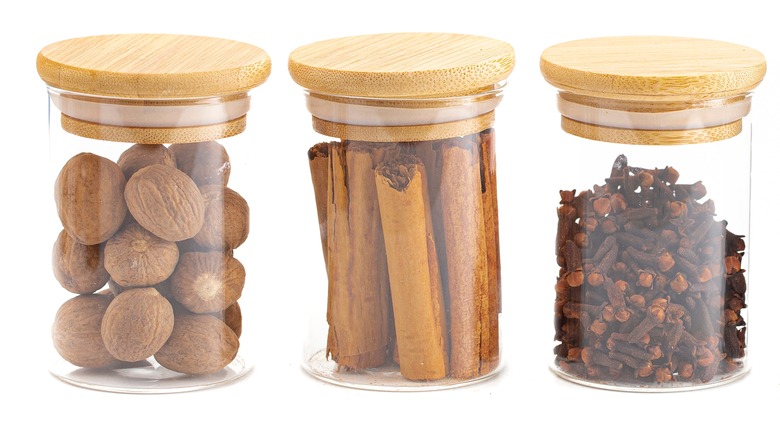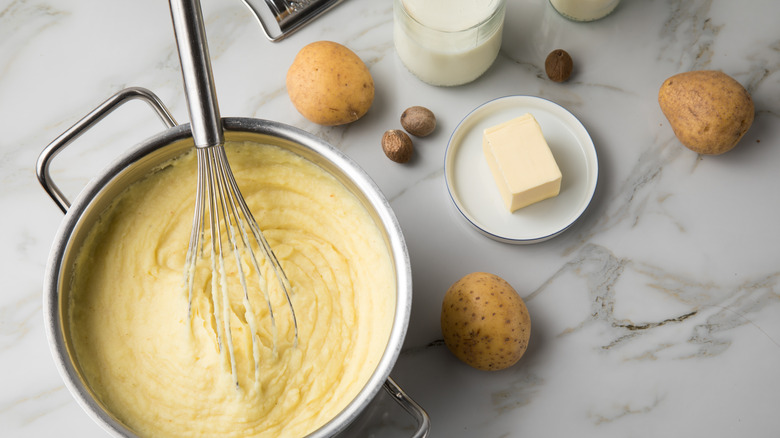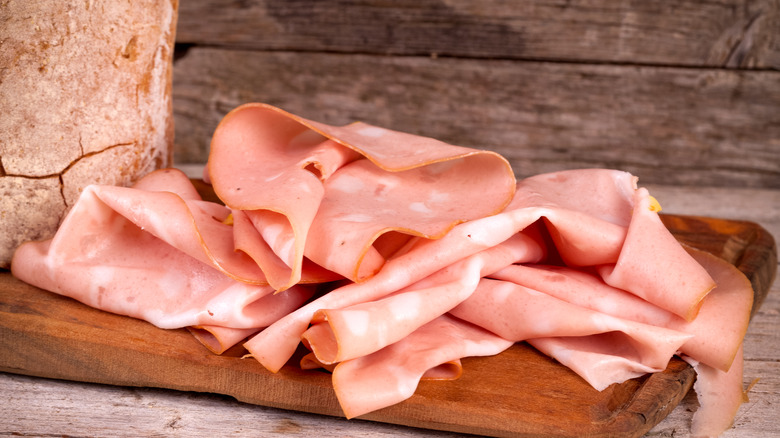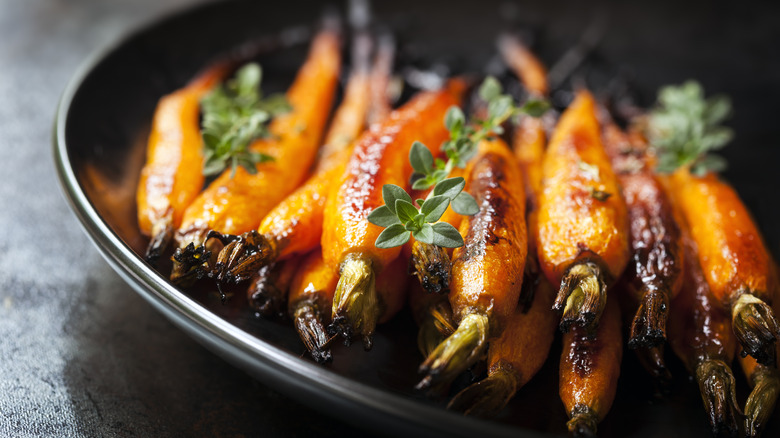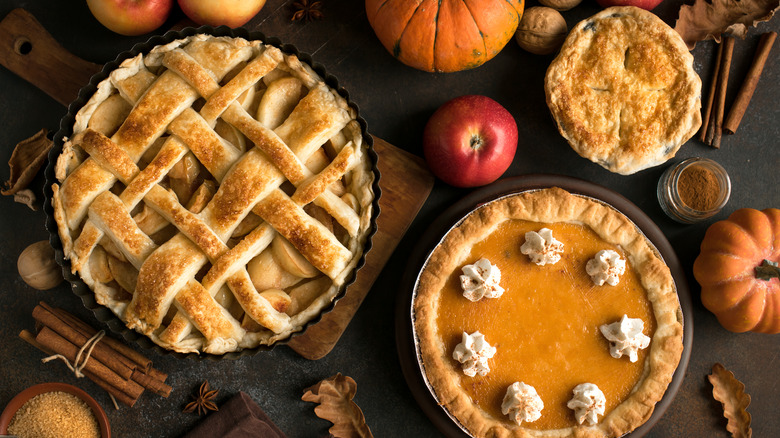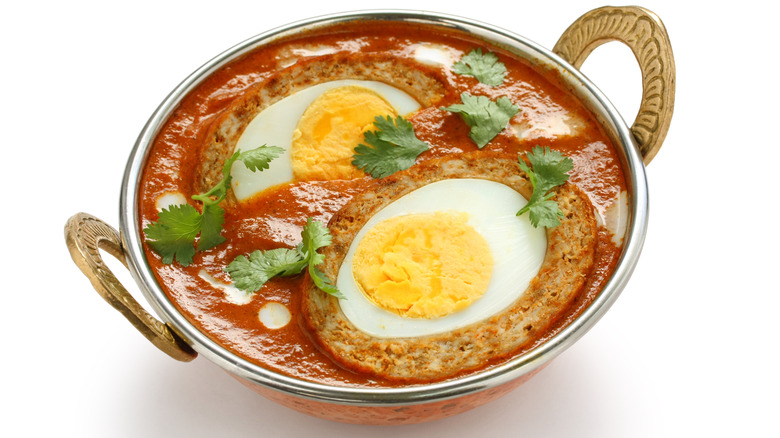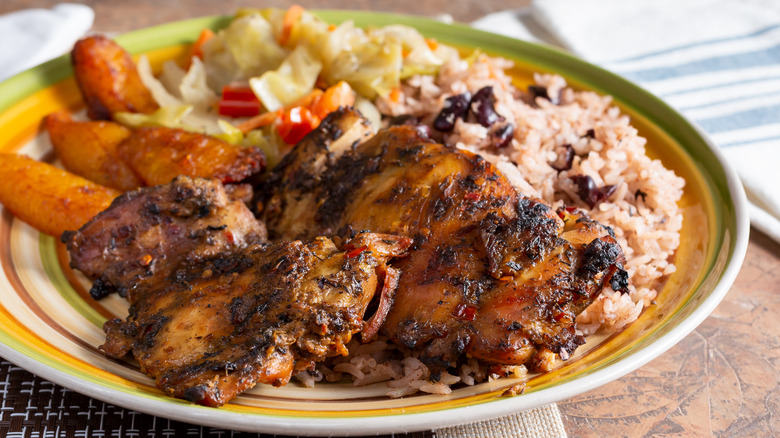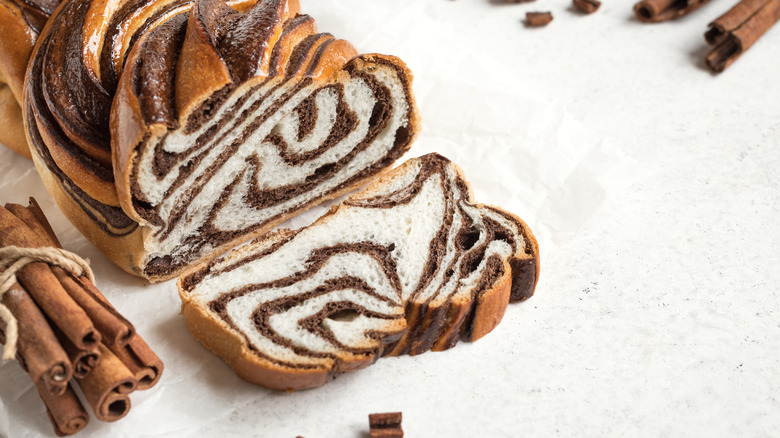12 Tips To Know When Cooking With Nutmeg
We may receive a commission on purchases made from links.
A spice that carries the very flavor of winter holidays, nutmeg is an essential product to keep in your pantry. Aside from lending its naturally sweet and nutty aroma to the famous pumpkin spice mix, nutmeg goes well with other sweet or savory dishes, from dairy-based sauces to apple pie. Nutmeg is actually the seed of a tree native to Indonesia. You can usually find it ground or whole, as well as nutmeg essential oil or butter. Per WebMD, the seed offers many health benefits, such as maintaining dental health, helping to improve one's mood, or aiding sleep.
According to World History Encyclopedia, the tree that produces nutmeg originates in the Indonesian Banda islands, which belong to what was known as "the spice islands" in the 1500s. Despite being popular in European cuisine, nutmeg was virtually inaccessible to Europeans directly, as Arab merchants controlled the market for hundreds of years. That's why the discovery of the spice islands by the Portuguese in 1512 led to fierce battles among European countries, which fought for control over the incredibly profitable spice market. Thankfully today, the plant that produces nutmeg grows in other parts of the world, too, so the delicious spice is widely available. Here are some tips for using nutmeg when cooking.
Grate the fresh seed
Like many other spices, nutmeg has a stronger intensity when freshly grated. This is because the seed contains volatile oils, which are responsible for the intense aroma and are better released when the seed is grated. Ground nutmeg will also retain some of these flavors, but they will have less strength. However, you can use the packs of ground nutmeg you can find in the stores for those recipes where you mix nutmeg and other spices because it's harder to distinguish the difference when you have more aromas. You can grind nutmeg using a grater or a nut mill. A handy tip when using the whole nutmeg is to grind only as much as you need for one recipe so that the volatile oils in the nut don't evaporate.
When using a grater, opt for a stainless steel microplane zester or the smallest holes in a cheese grater. To crack open the nutmeg shell, press down on the seed using a large knife or a heavy pan. After the shell cracks open, peel it away and grate the seed. It's best to aim for a 45-degree angle while grating to protect your fingers and expose the seed to the grater's blades as much as possible. Another way to grind a nutmeg seed is to chop it with a nut grinder. Load the peeled seed into the grinder and grind until it is finely grated.
Store in a cool, dark place
Nutmeg oxidizes and loses the volatile oils that provide flavor when in contact with air. Because of this, you should store nutmeg in an airtight container. The best containers are made from glass, which, unlike plastic, is not porous. Storing nutmeg in an airtight container will lengthen its shelf life by a few months, whether you have whole or ground nutmeg. However, if you have the whole nutmeg, you should only grate what you need for a dish and keep the rest in one piece, as it will last longer and have a more robust flavor.
The place where you store the spice is also essential. Moisture is harmful to nutmeg, as the spice will absorb water and lose its flavor. If you have ground nutmeg, moisture will cause it to clump. Sometimes, this can lead to mold, which can be toxic for you. Another aspect you should pay attention to is heat. It will cause nutmeg to lose its flavor, and it can also cause condensation inside the container. Light can also harm nutmeg, as it can cause the flavor molecules inside the spice to break down faster and make it lose its aroma. To protect nutmeg from light, you can either store it in an opaque container or use a clear container, but keep it in a closed spice cabinet.
Add nutmeg to your mashed potatoes
Mashed potatoes are that creamy, golden side dish synonymous with comfort and homemade cooking. Whether you associate the dish with Thanksgiving, Sunday lunch, or an ordinary meal, mashed potatoes are a foolproof way of rounding up a meal. Most home cooks add milk and cream to their mashed potatoes, but many other ingredients can elevate your dish. For example, nutmeg is an unexpected spice you can add to your mashed potatoes.
Although it is commonly associated with sweet dishes and desserts, such as pumpkin pie or pumpkin spice latte, nutmeg goes very well with savory dishes. In addition, it is delicious when associated with dairy, as its earthiness and warmth will balance the creaminess that characterizes foods containing milk or cheese. For this reason, nutmeg is also used in cream-based sauces or cheesy dishes. When making mashed potatoes, you can either add ground nutmeg at the end of the preparation process or heat the milk with nutmeg and butter and add it to the mashed potatoes. The second preparation method will ensure that the milk is infused with the flavor of the spice. Also, straining the milk before adding it to the potatoes will get a smoother texture.
Nutmeg goes well with Italian mortadella
Interestingly, nutmeg is one of the defining spices used in mortadella, a typical Italian food. Mortadella is a type of Italian deli meat made from ground pork and seasoned with lots of spices. It can also include pistachios, truffles, and myrtle berries, generally foods that go well with the salty and aromatic taste. According to Science Direct, the flavors used in mortadella include pepper, garlic, nutmeg, cinnamon, cloves, and coriander. Aside from being a part of sandwiches, mortadella can be mixed with soft cheese and turned into a mousse. As a mousse, you can use mortadella as stuffing for different types of pasta.
Another way of eating mortadella is to include it in a pork meatball recipe. The combination will up your meatball game, as this recipe enhances the flavor of the spices in mortadella by adding freshly grated nutmeg and freshly ground black pepper. Mix the mortadella with prosciutto, ground pork, and Parmigiano-Reggiano cheese for a taste that is saltier and more flavorful than your usual meatballs. The rich nutmeg-flavored meatballs also include eggs to bind the composition, and milk-soaked bread, for a smoother texture. They go well with marinara sauce and are great as an antipasto or over spaghetti.
Pair it with vegetables
The warm, nutty flavor of nutmeg is very versatile, as it is suitable for both sweet and savory dishes, and it works equally well with meat, vegetables, and some fruit. The earthy taste is ideal to counterbalance or complete certain sweet or creamy dishes and can result in great combinations with other spices.
Nutmeg goes well when added to certain vegetables. The best combinations result from pairing it with sweet-tasting vegetables, such as carrots or pumpkin, or cruciferous vegetables, such as cauliflower or Brussels sprouts. For example, nutmeg gives roast cauliflower a sweet touch and enhances its natural flavor. It also can transform Brussels sprouts into a delicious Christmas side dish when they are stir-fried. And, if you're curious about what carrots are capable of, try this Moroccan-spiced carrots recipe. The sweet, roasted, and caramelized carrots are covered with a spice mix called "berbere spice," which consists of paprika, coriander seeds, fenugreek, garlic powder, allspice berries, cinnamon, ginger, nigella seeds, nutmeg, cardamom, cloves. The versatile aroma explosion will compliment the carrots nicely and transform them into a star dish.
Use it in cheesy dishes
Cheese and dairy pair excellently with nutmeg in sauces, as they are hearty and creamy, and nutmeg possesses a necessary quality that elevates these dishes. The best example is béchamel sauce, one of the five French "mother sauces," which has an entire category of secondary sauces derived from its recipe. It is basically a milk and butter sauce, thickened with flour and flavored with nutmeg (and sometimes bay leaf). Béchamel sauce is used in many foods, such as lasagna, mac and cheese, or cauliflower cheese.
Another dairy sauce that can be flavored with nutmeg is Alfredo sauce. Of course, the best version is the home-cooked Alfredo, but you can spice up store-bought Alfredo by adding a pinch of nutmeg. Make the sauce from scratch by combining melted butter with garlic cloves, Italian herbs, double cream, and parmesan, and sprinkle with nutmeg when it's done. Like in many other recipes, freshly grated nutmeg is more flavorful and tastier than ground nutmeg. Nutmeg is also great when added to soufflé, a baked egg dish originating in French cuisine. Classic soufflé includes cheese, eggs, milk, butter, and flour and is perfectly aromatized with nutmeg and lemon juice. Just make sure that you are patient enough for your soufflé to rise properly before removing it from the oven.
Use it in fall pies
Fall pies, especially the quintessential pumpkin pie, have that unique flavor recalling family gatherings, Thanksgiving, and chilly mornings. Part of that very appealing flavor is nutmeg, a spice included in many pie recipes, such as pumpkin pie and apple pie. Actually, this classic pumpkin pie recipe features nutmeg and a combination of pumpkin pie spices that includes cinnamon and ginger. Canned pumpkin purée is better suited for making the pie, as it will ensure that the filling is creamy and sweet. Also, opt for a frozen pie crust because this balances the ingredients out perfectly and guarantees that the crust will bake evenly.
Another fall pie that comes with a nutmeg flavor is apple pie. This Dutch apple pie recipe uses a special Dutch spice mix called "speculaaskruiden." As it's nearly impossible to find in U.S. supermarkets, you can make your version of the four-spice mix using 1½ teaspoon cinnamon and ¼ teaspoon powdered cloves, nutmeg, and ginger. The Dutch apple pie is a high-sided crust pie that holds an ample amount of filling. If you want another dish to remind you of autumn, but are not a fan of pumpkin purée filling, give pumpkin bread a try. The recipe uses the same flavors as the Dutch apple pie, combining cinnamon, cloves, nutmeg, and ginger. However, the pumpkin purée is mixed into the bread, so the dish will have a very different texture from a pie.
Make a warm beverage
When it comes to warm, aromatic, and feel-good beverages, nutmeg flavor is a must for delicious autumn or holiday drinks. Think chai tea, mulled wine, or eggnog. Chai tea is a warm beverage that combines the warm, intense flavors of black tea, cinnamon, nutmeg, cardamom, ginger, star anise, and black peppercorns. All these are boiled in milk and sweetened with dark sugar. Chai tea isn't necessarily associated with any holiday, but the warm mix of spices is typical of the cold season.
Mulled wine and eggnog, on the other hand, are two holiday-centric beverages. Mulled wine is usually prepared with red wine, but white wine or cider is also well-suited. The wine is heated (not boiled) with a mix of spices, such as allspice, anise, cinnamon, cloves, nutmeg, and vanilla. Also, you can add fruit, sugar, or other types of alcohol (brandy, rum, or sherry). On the other hand, homemade eggnog only uses nutmeg to flavor the milk, cream, sugar, and rum. For eggnog, the essential aspect in preparing is to heat the milk and cream gradually, whisking constantly, and temper the eggs before adding them to the milk and cream. Otherwise, you risk ending up with cooked or curdled eggs.
Add to warm soup, stew, and curry
With its spicy, citrusy, and warm flavors, nutmeg is an excellent addition to Asian-inspired soups, stews, and curries. These dishes use the contrasting flavor principle that pairs nutmeg with dairy and certain vegetables to obtain a complex aroma, in which different tastes are balanced. For example, the carrot-cinnamon-nutmeg combination works well for a roasted side dish and a soup with an Indian touch. The result is a cream soup with a sweet taste and a complex aroma, balancing the carrots' natural sweetness. Nutmeg can also be added to beef or vegetable stews. In addition, it works exceptionally well with root vegetables, such as carrots, squash, and parsnip.
Nutmeg is also part of the spice combination in this spicy egg curry recipe. As part of garam masala, nutmeg works very well with other specific Indian spices, such as coriander, cumin, cardamom, cloves, black pepper, and cinnamon, to bring a unique, warm, slightly sweet taste. The curry preparation starts with chopping the onions, ginger, and chili and mixing them with garam masala, cumin, turmeric, and ground coriander. This combination is then cooked in butter and combined with tinned tomatoes, curry leaves, spinach leaves, and boiled eggs. The spicy egg curry is excellent when served with boiled rice or naan bread.
Make a spice rub
Spice rubs are a great way to enhance the flavor of your meat dishes, as they can entirely transform any meat. Whether beef, pork, chicken, or fish, every type of meat will benefit from an enhanced aroma. Some spice rubs can be used for vegetarian steaks, such as cauliflower or celery root. These spice rubs belong to the milder categories, as the taste should not overwhelm the aroma of the vegetables.
A great spice rub that includes nutmeg is the jerk chicken dry rub. Created by chef Dan Giusti, the recipe is targeted to school kitchens so that students can access tasty and healthy meals. It's a simple recipe that combines all the elements in one pan and can be cooked in the oven for maximum optimization. The dry rub combines allspice, cloves, nutmeg, salt, pepper, and brown sugar. The dry rub covers the chicken for two hours, and then the meat is covered with a marinade made with jalapeño pepper, scallion, garlic, ginger, olive oil, lime juice, and soy sauce. After chilling overnight, the marinade and spice rub-covered chicken is cooked in the oven for half an hour, resulting in a dish packed with flavors.
Add to a spice blend
There is a significant difference between a spice rub and a spice blend. Spice rubs are destined for meat and almost always include salt, while spice blends can be used for all purposes in various dishes. Also, spice rubs are used before cooking, while spice blends can be used before cooking, during, or after the dish is ready. This Portuguese allspice recipe has a distinctively earthy flavor, perfect for baked dishes or deviled eggs. It combines sweet paprika, black pepper, chili powder, cumin, cinnamon, nutmeg, allspice, dried oregano, ground ginger, ground cloves, one bay leaf, dried lemon zest, and dried orange zest.
On a completely different note, this homemade garam masala recipe opens the way for a world of Indian flavors. It goes well with soups and meats, comes with a little spicy kick, and is warming and flavorful. The secret to garam masala is toasting the seeds before grinding them. This way, the oils are released, and the taste of all the spices included in the mix increases. To make garam masala, mix cardamom seeds, black peppercorns, cloves, anise, cumin seeds, cinnamon, ground coriander, and ground nutmeg. Toast the whole spices before mixing, add the ground ones and then grind them together to release all the flavors.
Include it in a dessert
Pumpkin pie, apple pie, and pumpkin bread are not the only desserts that use nutmeg flavor. Babka, a traditional Jewish Eastern European bread, comes with all sorts of sweet and savory fillings. Chocolate, cinnamon sugar, apples, sweet cheese, Nutella, and raisins are the most popular sweet babka fillings. There are also savory babka varieties filled with za'atar and feta cheese. However, the traditional babka recipe is filled with cinnamon.
The cinnamon-filled babka gets an upgrade in this reinterpreted pumpkin spice babka recipe. The babka dough is a complex dish with milk, butter, active dry yeast, sugar, eggs, and a dust of cinnamon. It's the type of dough that needs time to rise (and double in size) and should be braided after filling. For the filling, add pumpkin purée, brown sugar, salt, ground ginger, ground allspice, ground cloves, and ground nutmeg to the classic cinnamon-sugar version. You will have a babka full of flavor reminiscent of the pumpkin spice mix that characterizes fall.
